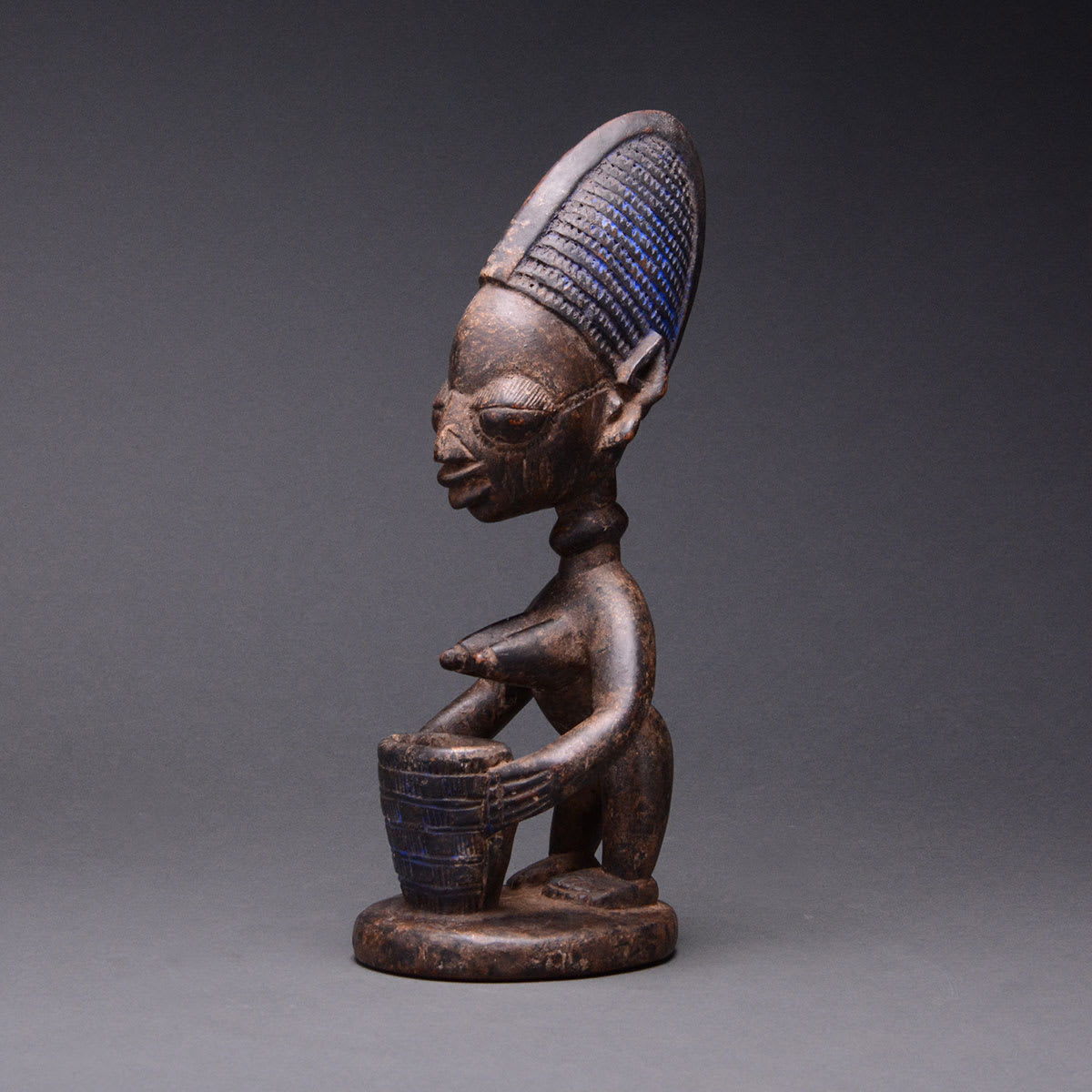Yoruba Wooden Shrine Figure, 1850 CE - 1920 CE
wood
height 31.1 cm
height 12 1/4 in
height 12 1/4 in
DA.412 (LSO)
Further images
This beautifully patinated sculpture of a standing woman with a high coiffure, her hands resting on the rim of a mortar, was made by the Yoruba of Nigeria. The proportions...
This beautifully patinated sculpture of a standing woman with a high coiffure, her hands resting on the rim of a mortar, was made by the Yoruba of Nigeria. The proportions are adapted, with short legs, long legs, a compact torso, enormous breasts, a ringed neck and an oversized head with the hair dyed using Reckitts Blue. The cheeks are marked with the traditional triple scars, and additional scars from the corners of the eyes to the hairline, and a line of incised lashes beneath each eye. The patina is extremely well-developed. It is likely to be a shrine figure. The identity of the person portrayed is likely to be an acolyte of Shango.
Shango (or Sango) was the fourth Yoruba king of Oyo-Ile. He had numerous rather colourful character traits that led to a mixed public opinion. When forced to commit suicide, thunder and lightning threatened to destroy the city; his ex-subjects interpreted this as an act of retribution and deified him as the god of thunder, hoping to appease him and also to harness some of his power. Latterly, Shango became associated with twins, rainfall, and for punishing miscreants with lightning strikes. His symbol is the double-headed axe, although dogs, rams (his preferred sacrificial animal) and kneeling women holding offering bowls/cups are also strongly associated with him. Finally, he is associated with art, music and beautiful women, so it is perhaps little surprise that he is such a popular deity (orisha) in the Yoruba pantheon.
The Yoruba are a Central Nigerian tribal group, originally descended from a Hausa migration from the northeast in about 900 AD. A small kingdom – Ile Ife – was founded by Oduduwa, followed by great sociopolitical expansion into Southwest Nigeria, Benin, and Togo. The influence of the city was felt far beyond these boundaries, however, and many smaller political entities were held under its sway. Communities were presided over by the Oba (king) and various senates (Ogboni), and councils made up of guild leaders, merchants and the lesser aristocracy (related to the Oba). The Yoruba have an exceptionally rich and diverse mythology, history and religious context, all of which are directly linked to their artistic output.
This is a beautiful piece of Yoruba statuary.
Shango (or Sango) was the fourth Yoruba king of Oyo-Ile. He had numerous rather colourful character traits that led to a mixed public opinion. When forced to commit suicide, thunder and lightning threatened to destroy the city; his ex-subjects interpreted this as an act of retribution and deified him as the god of thunder, hoping to appease him and also to harness some of his power. Latterly, Shango became associated with twins, rainfall, and for punishing miscreants with lightning strikes. His symbol is the double-headed axe, although dogs, rams (his preferred sacrificial animal) and kneeling women holding offering bowls/cups are also strongly associated with him. Finally, he is associated with art, music and beautiful women, so it is perhaps little surprise that he is such a popular deity (orisha) in the Yoruba pantheon.
The Yoruba are a Central Nigerian tribal group, originally descended from a Hausa migration from the northeast in about 900 AD. A small kingdom – Ile Ife – was founded by Oduduwa, followed by great sociopolitical expansion into Southwest Nigeria, Benin, and Togo. The influence of the city was felt far beyond these boundaries, however, and many smaller political entities were held under its sway. Communities were presided over by the Oba (king) and various senates (Ogboni), and councils made up of guild leaders, merchants and the lesser aristocracy (related to the Oba). The Yoruba have an exceptionally rich and diverse mythology, history and religious context, all of which are directly linked to their artistic output.
This is a beautiful piece of Yoruba statuary.







